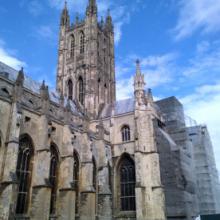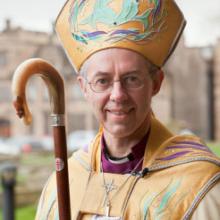women bishops
The Church of England’s commitment to advance the cause of women took another step forward March 26 with the appointment of Rachel Treweek, 52, as the next Bishop of Gloucester in the southwest region of England.
That makes three women bishops in the space of three months since the church overcame its long-standing opposition to women bishops late last year. On March 25, the church appointed its second woman bishop, Alison White, 58, as suffragan bishop of Hull.
But Thursday’s announcement was even more dramatic. Treweek will be the first to run a diocese on her own. She will be one rank below archbishop and will become the first woman bishop to sit in the House of Lords, the British Parliament’s Upper House.
Twenty-six “Lords Spiritual” — all Anglican, all male — sit in the House of Lords.
In a statement, Treweek said the appointment was “an immense joy and privilege.”
Twenty years after women were ordained as priests, the Church of England is set to appoint its first woman bishop by year’s end or at the start of 2015.
On Nov. 17, the church’s two most senior leaders, Archbishop of Canterbury Justin Welby and Archbishop of York John Sentamu, signed the change into church, or canon, law after asking the General Synod, made up of bishops, clergy and laity, to signal their approval by a show of hands.
The shattering of what’s called “the Church of England’s stained-glass window” marks the culmination of years of campaigning for reform.
In July, the synod, voted overwhelmingly in favor of legislation to create women bishops.
Hilary Cotton, chairwoman of Women and the Church, an advocacy organization, told reporters she is now hopeful the reform will lead to “changing the culture of the church.”
U.S.–born Christian Rees, a member of the synod’s House of Laity, said the Nov. 17 ceremony would change the public perception that the Church of England has “a problem with women.”
The Church of England’s vote to allow female bishops threatens unity with the Catholic Church, according to the editor of the Vatican newspaper, L’Osservatore Romano.
Giovanni Maria Vian, who is also a Rome historian, on Tuesday said the decision would have “an extremely negative impact” on steps to bring the churches closer together despite a positive meeting between Archbishop of Canterbury Justin Welby and Pope Francis a month ago.
“Clearly it’s a decision that complicates the ecumenical path,” Vian said in an interview with the Italian newspaper La Stampa published on Tuesday. “The problem is not only with Rome but also with Orthodox Churches, and that the Anglican Church is itself divided on the issue.”
After nearly 20 years of debate, the Church of England’s General Synod voted Monday to permit women priests to be ordained as bishops, overturning centuries of tradition in a church that has been deeply divided over the issue.
After 20 years of turmoil and angry debate, on Monday the General Synod of the Church of England said “yes” to women bishops.
The first could be named by the end of the year with the appointment of at least three additional women sometime in 2015, say senior church officials.
The General Synod is the three-tier governing body of the Church of England and it is made up of bishops, clergy, and laity.
At a meeting in York, the General Synod gave final approval to legislation introducing the changes by the required two-thirds majority.
Overall 351 members of the 433 Synod voted in favor of the measure.
The Church of England’s governing body has approved new proposals that would allow women bishops to be ordained by this time next year.
Meeting in London on Wednesday, the church’s General Synod passed a motion by 378-8, with 25 abstentions, that paves the way for the endorsement of women bishops. Bishops also approved a declaration that sets out guidance for parishes that reject female consecrations.
The package would end nearly two decades of bitter and damaging conflict, and the vote is a victory of sorts for the new Archbishop of Canterbury, Justin Welby, who was appointed last year just as the General Synod came within six votes of allowing women bishops.
The decision by the Church in Wales to consecrate women bishops means the Church of England — the mother church of the worldwide Anglican Communion — will be the last in Britain to admit women as bishops.
Cheers erupted in a hall at Lampeter, Ceredigion in Wales, when the 144-member governing body of the Welsh church announced the result of the vote on Thursday. A similar bill failed narrowly in 2008.
CANTERBURY, England — The Church of England’s governing body reaffirmed its commitment to consecrate women bishops with the aim of reaching final approval on an issue that has for so long split the church’s ranks no later than November 2015.
Meeting in York July 5-9, the General Synod agreed to consider new draft legislation by November this year.
This is the first time synod members have met since November 2012, when to the surprise of most of the British public, draft legislation to create women bishops narrowly failed to secure the requisite majority.






